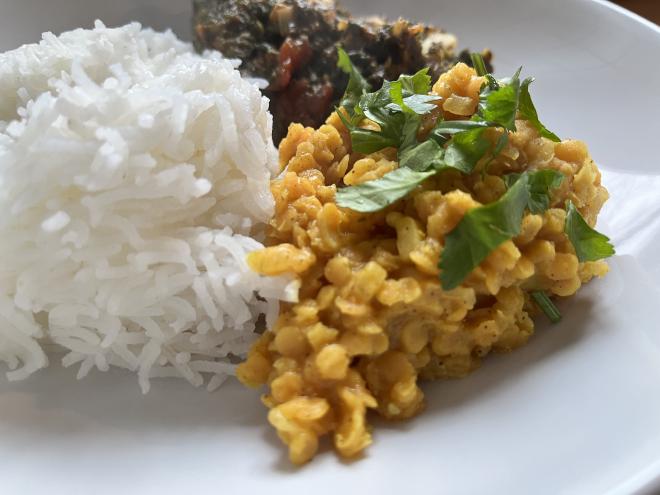Lime Dal: Lentil Curry with Lemon and Spices
Table of Contents
Jump to Recipe
Jump to Carbon Footprint
The lime dal is rather mild, soft and not particularly soupy, but the roasted onions give it a nice mouthfeel. The big trick with this and many other curries is to fry the spices in oil: This technique is known in Indian cuisine as tarka. By heating the spices, their aromas are better released and reveal a new, deeper level of flavour. Good Indian restaurants do this to perfection - to be honest, to a degree that I have yet to achieve at home. ✨ The lentils provide a good counterpoint to the spices, and the acidity of the lemon adds a pleasantly fresh note.

The recipe is based on the cookbook “India - The World Vegetarian” by Roopa Gulati (publisher’s website), which I like a lot.
The original recipe calls for “urad dal”, lentils from the state of Punjab in north-west India, which have had their darker skin removed and are therefore white. They are not always easy to find in my area, but I have had good luck with ordinary brown lentils. For this recipe, it is important to use a type of lentil that does not break down when cooked - not red lentils, for example.
The recipe itself is relatively straightforward, and you can do it one step at a time - there’s always a time when something is sitting around slowly simmering. However, the kitchen can look like a battleground afterwards: You’ll be using four hobs, two pans and two saucepans for this recipe. But I promise it’s worth it! 🥰
If you’re still looking for other great curry recipes, check out this one for palak paneer. It’s based on the same cookbook and you can see it in the background of the photo above.
Recipe #
Lime dal: Lentil curry with lemon and spices
40 minutes
2 portions
Ingredients #
For the curry:
- 150g dried white urad lentils (alternatively: yellow or brown lentils)
- 1/2 tsp ground turmeric
- 1 small onion
- 2 cloves of garlic
- 3 tablespoons sunflower oil
- 1/4 teaspoon dried chillies
- 1/4 teaspoon cinnamon
- 1/2 teaspoon cumin seed
- 1/2 teaspoon coriander seeds, alternatively coriander powder
- 1 pinch of salt
- Juice of one lemon
- about 5g fresh coriander
For the fried onions:
- 1 onion
- 1 pinch of salt
- 1 teaspoon flour
- about 20g sunflower oil
As a side dish
- about 120 g of rice
Directions #
- Bring the lentils to the boil in a saucepan with double the amount of water, a pinch of salt and half the turmeric. Cover the pan and simmer on a low heat for about 20 minutes, until the lentils are tender but still hold their shape.
- In a second pan, cook the rice with double the amount of water and a pinch of salt according to the packet instructions.
- Prepare the fried onions: Peel and slice the onion into rings. Mix with the salt and flour in a small bowl. Heat a little oil in a frying pan and fry the onion rings over a medium-low heat until golden brown. If they are ready before the rest of the ingredients, remove from the heat and set aside.
- Peel and chop the onion and garlic.
- Heat the oil in a frying pan and fry the chillies, cinnamon and cumin for about 30 seconds. Add the diced onion and garlic and cook for about 5-8 minutes, until the onion is soft. Reduce the heat to low, add the coriander seeds and remaining turmeric and cook for a further minute or so.
- Pour the spice/oil mixture over the lentils, season with salt and stir to combine. Cover again and leave on a low heat for a further 5-10 minutes to allow the spices and lentils to combine.
- Roll the lemon lightly on the table to release more juice, then squeeze. Add the juice to the pot with the lentils and spices and stir gently. Wash and chop the coriander. Serve the rice and curry with the fried onions and coriander.
Carbon Footprint #
In total, two portions of lime dal have an estimated carbon footprint of 1003 g.
This ranks it number 13 out of 57 recipes published on the blog so far in terms of estimated carbon footprint.
This means that it belongs to the quarter of recipes that have the lowest climate impact (i.e. top 25%). 🥰In terms of individual ingredients, rice and sunflower oil are the most prominent: Rice is typically grown on rice terraces, which are periodically flooded. This causes the soil to decompose, releasing methane - and unfortunately methane has a relatively strong impact on the climate (source). In the case of sunflower oil, this is probably due to emissions from the process of pressing the oil from the sunflower seeds.
| ingredient | carbon footprint per kg | carbon footprint (in g) for 2 servings | % of ingredients | % of CO2 emissions |
|---|---|---|---|---|
| Lenses | 1.2 | 180 | 26% | 18% |
| Turmeric | 0.5 | 1 | 0% | 0% |
| Onion | 0.2 | 12 | 10% | 1% |
| Garlic | 0.4 | 2 | 1% | 0% |
| Sunflower oil | 3.2 | 96 | 5% | 10% |
| Chili powder | 3.8 | 4 | 0% | 0% |
| Cinnamon | 0.7 | 1 | 0% | 0% |
| Cumin | 1.1 | 2 | 0% | 0% |
| Coriander seeds | 1.2 | 2 | 0% | 0% |
| Salt | 1.4 | 4 | 1% | 0% |
| Lemon | 1.9 | 162 | 15% | 16% |
| Coriander, fresh | 1.2 | 6 | 1% | 1% |
| Onion | 0.2 | 16 | 14% | 2% |
| Salt | 1.4 | 1 | 0% | 0% |
| Flour | 0.9 | 4 | 1% | 0% |
| Sunflower oil | 3.2 | 64 | 3% | 6% |
| rice | 3.1 | 372 | 21% | 37% |
| Cooking lentils | 34 | 3% | ||
| Cooking rice | 26 | 3% | ||
| Roast the onions | 11 | 1% | ||
| Fry the spices | 1 | 0% |


